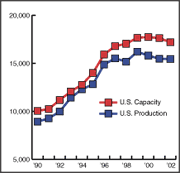 |

| U.S. FORECAST (000) |
2000 |
2001 |
2002e |
| U.S. Production |
15,804 |
15,471 |
15,450 |
| U.S. Capacity |
17,740 |
17,617 |
17,200 |
| Utilization Rate (%) |
89.1 |
87.8 |
89.8 |
| Imports, 000 tons |
820 |
836 |
845 |
| Exports, 000 tons |
221 |
261 |
250 |
| Apparent U.S. consumption |
| 000 tons |
16,403 |
16,046 |
16,045 |
lb/capita
ooo tons/billion $ |
119.2 |
115.5 |
114.4 |
| real GDP (1996) |
1.8 |
1.7 |
1.6 |
| Source: American Forest & Paper Assn. and RISI e=estimate. GDP= gross domestic product TOP N. AMERICAN PRODUCERS |
| Company |
Annual capacity (000 tons) |
Market share (%) |
| 1. Smurfit-Stone |
2,240 |
13.0 |
| 2. Weyerhaeuser |
1,495 |
8.7 |
| 3. Newark Group |
1,340 |
7.8 |
| 4. Rock-Tenn |
1,280 |
7.4 |
| 5. Caraustar1 |
1,078 |
6.3 |
| 6. Sonoco |
904 |
5.3 |
| 7. Inland Paperboard1 |
859 |
5.0 |
| 8. Norampac |
775 |
4.5 |
| 9. Pratt Industries |
600 |
3.5 |
| 10. U.S. Gypsum |
530 |
3.1 |
| 11. Solvay Paperboard |
525 |
3.1 |
| 12. Graphic Packaging |
330 |
1.9 |
Total U.S. capacity (2002): 17,200,000
Capacity share of top five companies: 43.2%
Capacity share of top ten companies: 64.6% |
|
1. Includes 50% of Premier Boxboard Ltd. joint venture
|
|
Recycled paperboard: Weak demand, overcapacity put pressure on sector
by NOEL DeKING, News Editor
INDUSTRY STRUCTURE. Recycled paperboard is made from 100% recovered wastepaper—collected from paper manufacturing and converting plants and postconsumer sources—and represents the largest single market for recovered paper in the U.S. This year, paper mills primarily producing recycled paperboard will purchase about 19 million tons of wastepaper.
The most important end uses for recycled paperboard are folding cartons, corrugated containers, rigid set-up boxes, composite cans, paper tubes and cores, gypsum wallboard, solid fiber partitions, book covers and binders, and insulation board. The major end uses measured by paper mill capacity are linerboard (29%); corrugating medium (26%); folding cartons (16%); gypsum wallboard (11%); tubes, cores, and other converting grades (18%). The converting grades include miscellaneous products such as spiral tubes and cores, composite cans, fiber drums, tags and labels, file folders, writing tablets, book cover stock, and game boards.
PRODUCTION/CAPACITY. Total demand for recycled paperboard increased about 50% during the ten-year period 1990 to 2000, but industry production has declined the past two years due to the economic slowdown in the U.S. The fastest-growing segments have been 100% recycled linerboard and corrugating medium used for corrugated shipping containers. Recycled linerboard and corrugating medium accounted for about 90% of total new capacity additions during the past decade. Production of recycled paperboard for gypsum wallboard has also grown. At the same time, the output of folding cartonboard and uncoated chipboard grades, setup boxboard, and some miscellaneous grades has declined. Total U.S. production capacity is currently about 17 million tons.
The industry is undergoing significant restructuring, as a series of mergers and asset sales have consolidated market share and led to rationalization of capacity. This year, Inland Paperboard and Packaging Inc. acquired Gaylord Container Corp. and immediately announced the shutdown of four paperboard machines. In the past 18 months, a total of 13 smaller recycled paperboard mills have closed, mainly due to high operating costs. The average output of these mills was 50,000 to 75,000 tpy, ranging in age from 75 years to 144 years. During the same period, four new operations have started producing recycled paperboard for gypsum wallboard and containerboard.
OUTLOOK/PRICING. In general, recycled paperboard markets are very competitive and strongly influenced by the U.S. domestic economy. The economic slowdown that started last year, combined with rising wastepaper costs, has placed additional pressures on recycled paperboard mills. The delayed recovery in industrial and consumer output will also delay the recovery for paperboard packaging markets.
The subdued nature of the recovery will keep capacity utilization rates near 88% to 89%, even as producers continue to take downtime and withdraw surplus capacity. This will be well below the 95% average operating rate that is typical of full production in normal markets.
Another major concern for recycled paperboard mills is the volatility of recovered paper prices, particularly old corrugated containers (OCC) and old newspapers (ONP). Fiber costs represent about 25% of total manufacturing costs at a typical recycled paperboard mill. Rising wastepaper costs will put upward pressure on paperboard prices, even in a weak market.
Paperboard prices have declined the past two years. The last price increase of $50/ton for coated recycled folding carton grades moved in the second quarter of 2000, in response to higher costs for fiber, energy, chemicals, and freight. Since then, prices for all grades have declined. Current average East Coast prices are about $410 to $420/ton for linerboard grades; $550 to $560/ton for coated folding cartonboard grades; and $380 to $400/ton for uncoated chipboard grades.

|